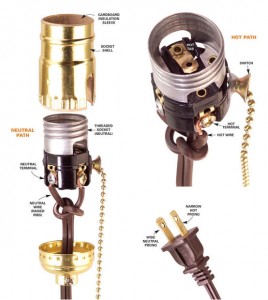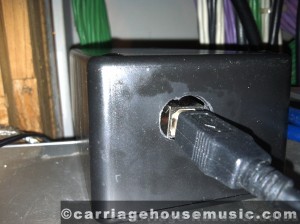DISCLAIMER: This project involves electricity, resistors, usb cords!, and an ability to think – don’t burn your house and/or studio down. also i’m not liable so there!
WHAT YOU WANT:
A recording status light (so someone doesn’t walk in on you mixing your Charlie Brown Christmas Dubstep remixes…..)
WHAT YOU NEED:
- 5v Relay – Radioshack
- Arduino Uno
- Electrical cabling – lamp wire is fine so long as using a low wattage bulb like led or compact fluorescent
- 1kΩ resistor – pull down resistor
- Radioshack wires solid – because stranded sucks!
- 25 Pin D-Sub Male Solder cup
- limited soldering skill plus solder & soldering iron
- an enclosure for your device like this project enclosure
- small pc board
- IC socket
- light bulb outlet
- red compact fluorescent bulb (13 w)
- (optional) diode and transmitter (check out Glacial Wanderer’s post)
Took a bit of brain prodding and help from Avid Audio Forums – here is the DIY for how to make a recording light using Pro Tools w/ Sync I/O. (Hopefully in the future i will figure out one that doesnt require the sync io).
Our main room had this old fashioned bulkhead light, just a normal light – but i said HACK THAT $#!%
Oh what to do with this light that kind of looks like a recording liGHT… IDEA! insert red bulb and … oh how do i get this thing to work with pro tools?
The next couple days…. actually weeks led me to seek out any information on the web about this diy endeavor. Alas to no avail… i first found a MAKE blog post about a networked recording light
AHA enter ARDUINO – friend of those in diy need (generally). got me thinking about the arduino but with little know how i put that on the back burner.
instead i started looking at the sync io – i had heard about the gpi port of the sync io that it had some controls but didn’t know much about it. here is a link to the pdf Sync IO Guide starting at page 82 is where it gets good. If you read on you get the sense that the gpi outputs voltage or signal through the pinouts 1&2 which if you continue to read on corresponds to the #4 & #5 GPI triggers the TTL outputs for stop and record. The manual says a logic level of 3.3v – didn’t go to school for electrical engineering (just mechanical) but when i searched online and used my dmm i got a reading of 5v. ::shrug::
PROOF OF CONCEPTING…TION
First thought – relay 5v should work. Got one from radioshack – went about testing my light and relay concoction with a bunch of help from this Glacial Wanderer post – Using relays with arduino. Note you must put the relay in line with the POSITIVE or LIVE wire (not negative or ground). Also I used lamp wire (no ground wire just + -). Use the code on the page if you want (i didn’t go that far) i just used the Arduino Blink tutorial. For this test you need a lamp wire with light outlet (it can be the one you will use for your final installation – i just happened to use a different one for proof of concept. Now i didn’t build the circuit with the transistor and diode but i would love to know if it is a necessity from someone with an electrical engineering mind. i understand back EMF just wondering how necessary it is especially with regard to the low wattage (whether that means i am low wattage or the bulb).

This thing right here….
REAL TIME
Once you are done prototyping (no pressure) – now would be a good time to think about the enclosure and how your toy will fit into and around your gear. I ended up making modifications after the fact because i needed a very long cable from the SYNC I/O to the arduino and the arduino via relatively short usb to the computer. I suggest a simple project enclosure – exceedingly basic but works fine.

RELAY
So figure out the relay – the schematic below is for the OUAZ-SS-105D (the one you’ll get from radioshack probably). The contacts that connect to what looks like a little resistor controls the relay – this will come from the arduino (or sync io if that works for you). Your POSITIVE/LIVE wire that you split will connect between the 2nd contact from the top left on one end of the live wire and the other part of the cut wire to the bottom right contact. Be careful if you are soldering directly to the relay that you don’t break the pins or accidentally connect two pins together via a solder bridge resulting in the light staying on all the time no matter the switch.
To avoid this (after a first failed attempt at directly soldering to the relay) I instead opted to use an IC Socket soldered to a PCB.


SO before i proceed on with the arduino – the reason I mentioned previously that you may not even need the arduino is that i had already built the arduino with the relay and proof of concept-ed it however i didn’t work on first go around and the circuit instead required that I implement a pull down resistor. It seems like the pull down resistor, relay, and wire is all you really need as the SYNC I/O should output 5v but i did not test this and use this info with caution – not sure if it would cause any problems with the sync io and in that case i would be more inclined (for whatever reason) to have built the back EMF protective circuit.
ARDUINO CODE
Thanks to junkgear on Avid Audio Forums i was pointed in the right direction towards switch but i ended up using Button – as switch would turn it on keep it on through low then switch it off once went to high again. Didn’t change anything in the code – works fine.
/*
Button
Turns on and off a light emitting diode(LED) connected to digital pin 13,
when pressing a pushbutton attached to pin 2.
The circuit:
- LED attached from pin 13 to ground
- pushbutton attached to pin 2 from +5V
- 10K resistor attached to pin 2 from ground
- Note: on most Arduinos there is already an LED on the board
attached to pin 13.
created 2005
by DojoDave <http://www.0j0.org>
modified 30 Aug 2011
by Tom Igoe
This example code is in the public domain.
http://www.arduino.cc/en/Tutorial/Button
*/
// constants won't change. They're used here to set pin numbers:
const int buttonPin = 2; // the number of the pushbutton pin
const int ledPin = 13; // the number of the LED pin
// variables will change:
int buttonState = 0; // variable for reading the pushbutton status
void setup() {
// initialize the LED pin as an output:
pinMode(ledPin, OUTPUT);
// initialize the pushbutton pin as an input:
pinMode(buttonPin, INPUT);
}
void loop() {
// read the state of the pushbutton value:
buttonState = digitalRead(buttonPin);
// check if the pushbutton is pressed. If it is, the buttonState is HIGH:
if (buttonState == HIGH) {
// turn LED on:
digitalWrite(ledPin, HIGH);
} else {
// turn LED off:
digitalWrite(ledPin, LOW);
}
}
Remember you have to download the arduino app – plug it in via usb – copy paste the code – upload. should be good barring any unforeseen errors.
GPI Port SYNC IO
GPI PORT Pins 2 and 14 are the pins you are interested in for the signal to your Arduino. Pin 2 is the 5v signal when in record and 14 is ground. Get yourself a 25 Pin D-Sub solder cup MALE connector. Solder a strand of wire long enough to reach the arduino which will be in your enclosure.

ARDUINO
The Arduino UNO (simple one with usb) can get power from usb which is how i have it hooked up now. Reference the schematic below – PIN 2 from GPI port will connect pcb. this connection requires a pull down resistor between the 5v from gpi port pin 2 and the ground (that makes it parallel) – the signal then goes to Digital In 2 of the arduino. GPI PORT Pin 14 can connect to ground on the pcb. Pin 13 from arduino will send 5v to the relay – you also need the ground adjacent to pin 13 on arduino to connect to other switch pin of relay. from what i can tell it doesn’t matter which one connects to which as the first connection i tried worked. may not be the same for all relays. A ground connection on the other side of the arduino must be supplied to the pcboard you have.

SCHEMATIC

When you connect the lamp wire to the PCB it is probably advisable to use the higher gauge lamp wire – i ended up using a short length wire to connect the pcb to the split positive wires of the light – fairly short couple inches.
Problem is those thin wires can handle only a limited amount of current – i believe 0.92 amps – a 13 watt bulb on a 120v line seems to me to yield a current of 13/120 = .1083 amps. so if your intent was every time protools turns on you want your heating, refrigerator and jacuzzi (or any of these) to turn on your best bet is attaching the lamp wire – not to mention that the relay will probably melt under that power (not intended to be a factual statement).
****oh if anyone knows how to keep the arduino from flashing when you plug it in (essentially it outputs 5v from pin 13 when you first plug in the usb cord – which in turn flashes the light) – it should be plugged in all the time. not sure actually if it flashes when i turn on the computer as i am never in line of sight with the recording light from the control room.
well i cant think of anything else and i’m tired…
NOW GO DO THAT VOODOO THAT YOU DO SO WELL!!!
RESOURCES

HI,
I love your record light but have you seen anything that that would work from MIDI?
I have a Saffire pro with no GPI port.
Than ks
Jim
I would recommend the https://punchlight.com which I was gonna use on our other system. Kinda pricey but has a relay option or a light option. Let me know if you found a better option. Good Luck!
hi,
i did a circuit very simple no need for arduino just a n opto isolator and a mosfet if you want i can send you the schem.
cordialement
Definitely send me the scheme – I’ll add it to the post.
This is awesome! My girlfriend actually made me a light up Recording sign for my birthday. She gave it to me with a remote which just seems like an extra step in an already difficult workflow. I ordered relays and an Arduino Uno but since I’m not using PTHD I don’t have the option of Sync I/O. Any idea how you would set this up with PT12 via MIDI?
The only thing that I’ve found is called https://punchlight.com which I was gonna use on our other system until I found another sync. Kinda pricey but has a relay option or a light option. I’m sure if you bought one of these you might be able to reverse engineer how it works, use midimonitor to see what it is sending, etc. Let me know if you figure anything out. Good Luck!